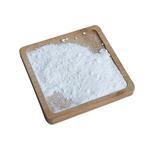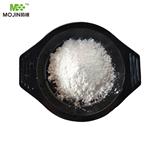Chemical Properties
Lead-gray, nonvolatile powder. Dapproximately 6.4. Insoluble in hydrochloric acidand hydrogen fluoride and alkalies, sparingly solu-ble in sulfuric acid.
Physical properties
Molybdenum(IV) oxide can be prepared by several methods including controlled oxidation of Mo and controlled reduction of MoO3 with hydrogen. The pure oxide suitable for structure determination has been prepared by electrolysis of a polymolybdate (K2O5.MoO3) solution. Molybdenum(IV) oxide is insoluble in water: it is inert in solutions of nonoxidizing acids or bases, but is dissolved by oxidizing solutions. It dissociates to Mo and MoO3 at high temperatures (~ 1100°).
Crystalline MoO2 is violet or brown. Its deformed rutile structure consists of infinite chains of MoO6 octahedra sharing opposite edges along the chain direction with Mo-Mo distances alternately long (3.10 A) and short (2.50 A). It is diamagnetic and semiconducting ; metal-metal bonds are present. Some of its thermodynamic properties are as follows: G°f29% ~ 172.415 kcal/mole H°f29% -140.5 kcal/mole S°298 11.954 gibbs/mole.
Uses
Molybdenum(IV) oxide is used to catalyze the dehydrogenation of alcohols. It is also used as an intermediates and processing aids. It finds application in the manufacture of molybdenum nano-wires.
Uses
Molybdenum(IV) oxide (MoO2) is a transition metal oxide with good electrical conductivity due to the presence of delocalized electrons in its valence band. It is traditionally prepared by reducing MoO3 in dry hydrogen in the temperature range of 450-550°C.
MoO2 can be used in a variety of energy based applications such as an anode material in rechargeable lithium batteries and fuel flexible solid oxide fuel cells.It can also be used as a catalyst in hydrogen reforming processes.
Preparation
Molybdenum(IV) oxide is obtained by passing steam over red hot molybdenum:
Mo + 2H2O → MoO2 + 2H2
Alternatively, the oxide may be prepared by heating a molybdate salt, such as ammonium molybdate, with a reducing agent such as zinc. The dioxide also may be obtained along with other oxides of molybdenum when molybdenum metal is heated in air.
A brown-black suspension of MoO2 in hydrate form may be obtained by reducing a solution of ammonium molybdate with hydrogen in the presence of colloidal palladium.
General Description
Molybdenum(IV) oxide (MoO
2) is a transition metal oxide with good electrical conductivity due to the presence of delocalized electrons in its valence band. It is traditionally prepared by reducing MoO
3 in dry hydrogen in the temperature range of 450-550°C.
reaction suitability
reagent type: catalyst
core: molybdenum
Safety Profile
Poison by
subcutaneous route. Incandescent reaction
with air. When heated to decomposition it
emits toxic fumes of Mo.
Toxics Screening Level
The screening level for the elemental molybdenum and insoluble molybdenum compounds is 30 μg/m3 while the screening level for soluble molybdenum compounds is 5 μg/m3 based on an 8 hour averaging time.




